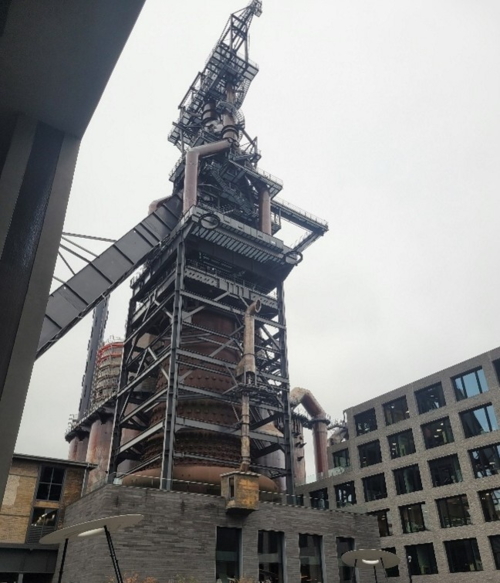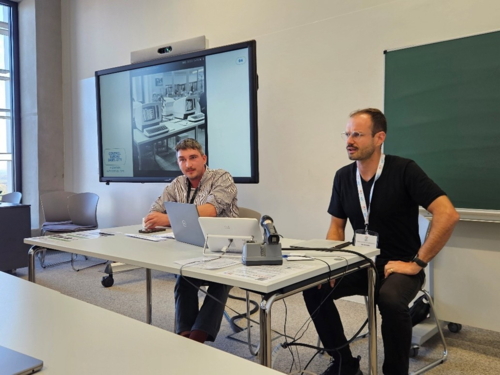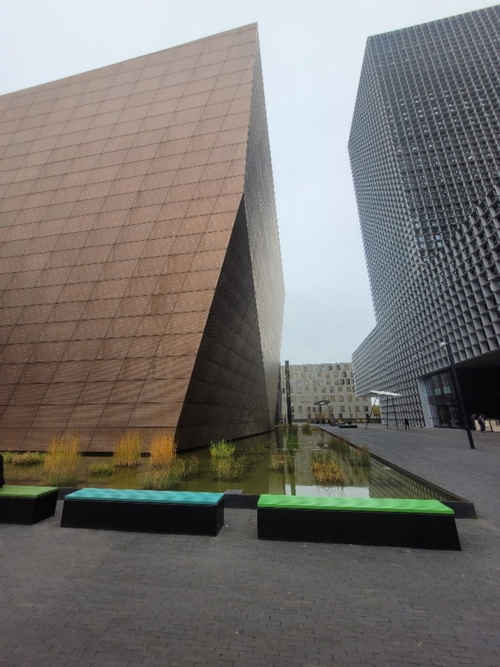Technologies of Migration – Migrating Technologies. The Digital Inequalities Team visits SHOT in Luxembourg

State-of-the-art buildings blend seamlessly into the remains of a steelworks on the campus of the University of Luxembourg in Esch-sur-Alzette. This architecture embodies the technological transformation from a modernity, dominated by heavy industry to a “knowledge society” in the 21st century. It was therefore an appropriate venue for the Annual Meeting of the Society for the History of Technology (SHOT), held there from 9 to 11 October, which three members of the 'Digital Inequalities' project group attended.
Lennart Schmidt, who had travelled from Paris where he is conducting research, provided an insight into his research project, 'Digital Migration Regimes: Technologies of Control in Postwar Europe'. In his presentation with Dr. Moritz Mähr from the University of Basel, he impressively argued that the 21st century is characterised by surveillance capitalism, whereas the 20th century was dominated by surveillance statism. They both participated in a panel organised by PD Dr Michael Homberg (ZZF) entitled “Digital Borders: Migration and Data Politics, 1950s to 2000s” in which Dr Moritz Feichtinger (also from the University of Basel) also participated. Dr Moritz Feichtinger was a ZZF fellow from May to July 2025 and presented his current research project on the surveillance of migration flows during the Vietnam War. Two further presentations were given: one by Cecilia Passanti (Université Paris Cité) on “The Civil History of Biometric Computers: Linking the 1960s African Independences to the Rise of Western Security Infrastructure” and Michelle Pfeifer (Dresden University of Technology) on “Infrastructural opportunism: Database Interoperability's Lessons from the German Central Foreigners' Register.”

photo: Michael Homberg (private)
In another panel on the topic of “The Local and the Universal: Organising European Computing in the 1960s–1980s” Dr Johannes Kleinmann (ZZF) presented his research on the transformation of working practices within the computer department of the Brandenburg an der Havel steel and rolling mill. He addressed local aspects of digitisation, such as the organisation of work on site, on the one hand. On the other hand, he considered these in the context of the universal dynamics of digitisation in the GDR, including political guidelines and the general scarcity of resources.

Both panels were very well attended and received positive feedback. Finally, it should be noted that Dr Mario Bianchini also represented the ZZF at SHOT. He also researches the history of the GDR and presented his research on the topic of 'Our Housekeeping: Public Imaginaries of Energy Gaps in the German Democratic Republic' at the conference.
However, the Digital Inequalities Team's research was also referenced in many other panels, of which I would like to highlight just two here. In her presentation, Prof. Martina Heßler (TU Darmstadt) provided insight into the so-called 'post-scandal' in Great Britain. In 1999, Royal Mail introduced the Horizon software system which wrongly accused numerous post office managers of embezzlement. As a result, more than 900 employees were dismissed, destroying many livelihoods and even driving some of those affected to suicide. Using this example, Prof. Heßler impressively demonstrated that technology is often trusted more than its users. Furthermore, those affected often lacked the necessary computer skills to recognise the malfunction.
This topic highlighted various aspects of digital inequality, such as who is believed and why, and who is not. Finally, Dr Dick van Lente (Erasmus University Rotterdam) gave a presentation on 'Computers in Cartoons: Dimensions of Public Response in Five Countries, 1950–2000', using Dutch cartoons to show how the perception of computers developed in the second half of the 20th century. It was particularly interesting to see how various aspects of inequality, such as gender, were negotiated, constructed, and criticised in these cartoons. Overall, the conference offered the project group numerous opportunities for interdisciplinary and international exchange, despite the extensive and dense programme not always facilitating this.
Finally, here are a few thoughts on the campus in Esch-sur-Alzette. While it is beautiful to see new buildings blending in with the old ones, the ground throughout the entire site remains completely sealed due to heavy contamination with pollutants, particularly lead and dioxins. In this respect, it is a striking example of how the material legacy of modernity continues to affect us. It also reminds us that digitalisation has not ended environmental pollution, merely 'migrating' it elsewhere. Just as people and the soil were poisoned in Esch-sur-Alzette several decades ago, the same is happening today in places such as the Congo, where the mining of coltan and manganese provides the raw materials urgently needed for digital infrastructure.


